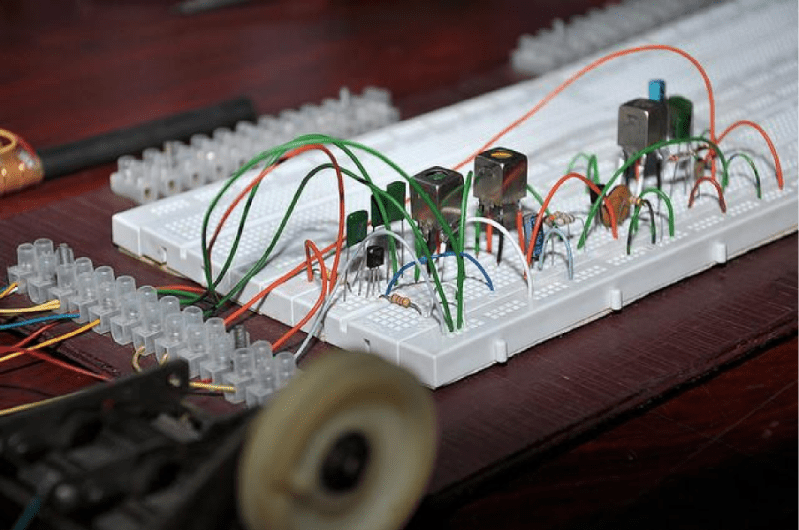Early radio receivers worked on a principle called Tuned Radio frequency (TRF), patented in 1916. They weren’t very easy to use, requiring each stage to be tuned to the same frequency (until ganged capacitors made that a bit easy). The Superheterodyne design, devised in 1918, was superior, but more expensive at that time. Cost considerations led adoption of the Superhet design to lag behind TRF until almost 1930. Since then, until quite recently, the Superhet design has been at the heart of a majority of commercial radio receivers. Direct Conversion Receivers were devised around 1930, but required elaborate phase locked loops which restricted their use in commercial receivers. The point of all this background is that the Superhet design has served very well for more than 90 years, but will soon be rendered redundant once Software defined Radio (SDR) becomes ubiquitous. Which is why this study of the simple Superheterodyne shortwave receiver deserves closer study.
[Dilshan] built this two transistor and two IF transformer based superheterodyne radio designed to receive 13m to 41m bands. The whole build is assembled on a breadboard, making it easy to teach others to experiment. [Dilshan] offers very useful insights into antenna, rod coil and IF transformer parameters. To dive in to Radio architecture, check this post on Amateur Radio. And if you would like to get a closer look at Antique Radios, check this post on Restoring Antique Radios.

















It’s good to see all the radio related hacks here lately.
I think that people tend to overlook radio, but it’s a huge part of modern life.
Indeed.
Surprised it works on a strip board without coupling or some problem. If you can use double tuned IF’s the performance would be usable, like when radios had them. Far less bleeding on strong stations into the rest of the band. Most likely source is tube era stuff. When they went to pocket sized radios the tall can double tuned IF was scrapped in favor of the tiny single tuned IF. It takes at least another IF stage to get similar response.
Beyond that classic radio design adds on in front another first school TRF stage. The best used 2 or 3 TRF stages all coupled on the same shaft as well as the superhet set. Thus 2 gang for starts 3 was the mark of a decent radio, as all car radios were. I have seen 4 and 5 in top end FM tuners.
Have you not of useing the 74HC4053 and 74HC00 as a downconverter when configured for double balenced operation.
Too bad the AM transmitters are being shut down or continue transmitting with decreased output power, at least in Europe. I still remember how I built my crystal set radio when 10 years old, receiving strong local transmitter. Nowadays the radio would be silent…
Or being overwhelmed by all possible noise radiated by CFL bulbs, switching power supplies, cellphones and PCs, powerline network adapters, etc.
Hard times for analog radio, sadly.
Here in the US we still have plenty enough whack jobs listening to talk radio to keep AM on the air.
I thought software defined radio replaced just the modulator and detector, and still used superheterodyne circuits to convert between a lower frequency band accessible to the software bandwidth limits and a higher frequency band that might be of interest.
It depends on how the radio is constructed. Some SDRs feed the antenna directly into the chipset with no filtering, though the only time I’ve seen this particular configuration is on an RTL-SDR receiver. I suspect that higher quality units, especially those with the capacity to transmit, will have some external filtering.
Most of the amateur SDR projects use direct conversion to I/Q signals. A fair bit of the filtering is done in software.
“Direct Conversion Receivers were devised around 1930, but required elaborate phase locked loops….”
Why would DC receivers require elaborate phase locked loops when superhets of the same era didn’t?
@biastee:
Quote from wikipedia, “Another issue is the inability of this design to implement envelope detection of AM signals. Thus direct reception of AM or FM signals (as used in broadcasting) requires phase locking the local oscillator to the carrier frequency, a much more demanding task compared to the more robust envelope detector or ratio detector at the output of an IF stage in a superheterodyne design.” Remember envelope detection is basically just a cap and a diode but it wont work if the freq is too high.
Nice article Anool. But now I’m going to have to study direct conversion receivers. As it is I can how a wide multimode SDR would be possible and how one could benefit from pass band filters. I’m just up on the details as of yet. However I have to believe for transmitter, thing are going to stay as they are for a time yet.